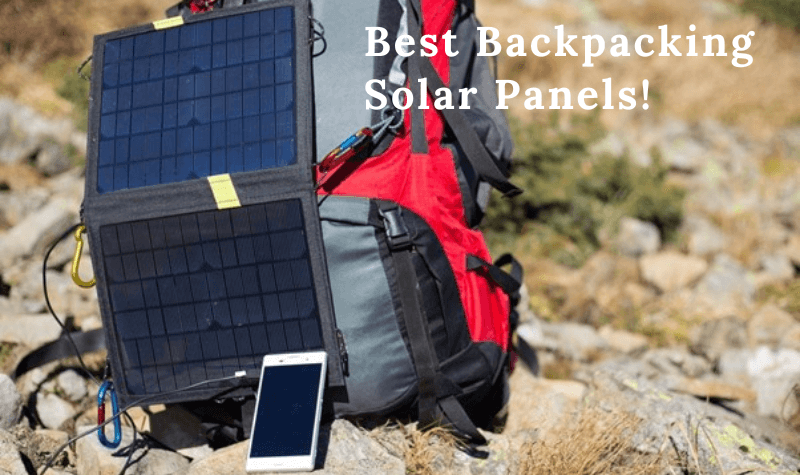If you’re a backpacker, or if you just like going out into nature and exploring, you know that one of the biggest challenges is keeping your gadgets charged. While there are many ways to do so, one of the most reliable and portable options is with solar panels.
But with so many different choices out there, how do you know which one is right for you? So, to ease your task, in this article we’ll review 5 of the best backpacking solar panels on the market today that I personally tried.
Also, we will look at a comprehensive buying guide to backpacking solar panels that will help you choose the perfect one. So, without further ado, let’s get started!
What are the Benefits of Solar Panels for Backpacking?
Solar panels are an increasingly popular option for backpackers and other outdoor enthusiasts looking to reduce their reliance on traditional forms of energy.
While solar panel technology has been around for decades, recent advances have made them smaller, lighter, and more efficient, making them a viable option for powering your devices while on the go. Here are some of the main benefits of using solar panels when backpacking:
- Solar panels can help you save money: Backpacking can be an expensive hobby but using solar panels can help cut down on costs by allowing you to power your devices for free.
- Solar panels are good for the environment: One of the great things about relying on renewable energy sources like solar is that they have little negative impact on the environment.
- They’re easy to set up and use: Most modern solar chargers come equipped with intuitive features like USB ports which make recharging quite simple!
- Solar panels can keep you connected: Solar panels can be a lifesaver by allowing you to charge your devices so that you can stay connected even while off the grid.
What are the different types of solar panels for backpacking?
The 5 main types of solar panels for backpacking are folding, handheld, monocrystalline, polycrystalline, and thin film!
- Folding solar panels are the largest and most efficient type of panel, but they can be bulky and difficult to transport.
- Handheld solar panels are smaller and more portable, but they’re not as efficient as larger models.
- Monocrystalline solar cells are made from a single crystal of silicon, making them more durable than other types of cells. They’re also the most efficient type of cell available, meaning that you’ll get more power per square inch with a monocrystalline panel than any other kind. However, monocrystalline panels tend to be more expensive than their polycrystalline counterparts.
- Polycrystalline cells are made from multiple crystals of silicon, and while they’re not quite as durable or efficient as monocrystalline panels, they’re more affordable.
- Thin film solar panels are the least expensive type of panel, but they’re also the least efficient. They work well in sunny conditions, but their output is significantly reduced in cloudy or shady areas.
How much do backpacking solar panels usually cost?
Backpacking solar panels are available in a variety of sizes and prices. The most common type is the handheld or the foldable solar panels, which usually costs less than $50. These panels are great for charging small devices like phones or GPS units.
For larger devices such as laptops, you’ll need a more powerful monocrystalline solar panel, which will cost more than $50.
How to get maximum efficiency from a solar panel?
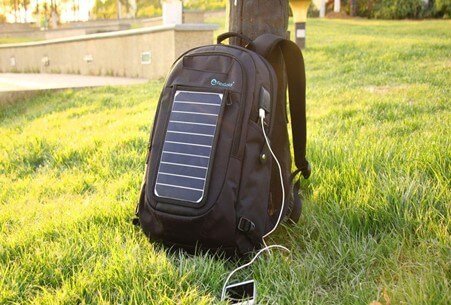
Solar panels are a great way to save money on your energy bill, and they’re becoming more and more popular as technology improves. If you’re thinking of getting a backpacking solar panel for your next outdoor trip, there are a few things you can do to make sure you get the most out of them.
First, it’s important to place your solar panel in an area that gets direct sunlight for most of the day. This will ensure that your panel is able to absorb as much light as possible, which is converted into electricity. Additionally, try to keep any trees or other obstacles from shading your panel – even partial shade can reduce its efficiency by up to 50%.
Also, every time you return from your outdoor trip, take some time to clean your solar panels. Dust and dirt can build up on the surface over time and block some of the sun’s rays from reaching the cells inside. Just use warm water and a soft cloth – no need for harsh chemicals!
Buying Guide to the Best Backpacking Solar Panels
Finding the best backpacking solar panels can be a tedious task. But don’t worry! We have taken the pains to put together a buying guide that will go through several important factors that one must consider before buying one.
So, what are these factors and how do they affect your buying decision? Well, let’s find that out below!
1. Weight and Size
When it comes to choosing the best solar panel for your backpacking needs, weight and size are important factors to consider. The last thing you want is a bulky solar panel that weighs you down on your hike.
Instead, opt for a lightweight and compact panel that can easily be carried in your backpack. Additionally, make sure to choose a solar panel with high efficiency so that you can maximize power output while minimizing weight and size.
2. Capacity
This is measured in watt-hours (Wh) and tells you how much power the solar panel can generate in an hour. A higher capacity means that more energy can be stored, which is ideal if you’re planning on using electronics while out on the trail.
Keep in mind that capacity varies based on conditions like sunlight intensity and cloud cover; so even though a panel might have a high Wh rating, it may not perform as well in real-world conditions.
3. Outlets
The more outlets there are, the more options you have for charging your devices. Some solar panels have USB ports, which can be used to charge phones and other small electronics.
Others have AC adapters, which allow you to charge laptops and other larger devices. If you plan on using your solar panel to power multiple devices at once, make sure that it has enough outlets to accommodate all of them.
4. Safety Features
When it comes to choosing the best backpacking solar panels, safety should be the primary concern.
After all, you don’t want your panel to overheat and cause a fire while you’re out in the middle of nowhere! Here are some things to look for when choosing a safe backpacking solar panel:
- Look for panels that have built-in temperature regulation. This will help prevent your panel from overheating.
- Choose a panel with durable construction. You want something that can withstand being dropped or bumped around on the trail.
- Make sure the panel has proper ventilation so heat can escape and won’t build up inside the unit.
5. Durability
When choosing the best backpacking solar panels, durability is an important factor to consider. Solar panels are exposed to the elements and can be damaged by sun, wind, rain, and snow. The most durable solar panels are made with tempered glass or polycrystalline silicon.
Tempered glass is less likely to break than regular glass and polycrystalline silicon is more resistant to damage from weathering. Solar panels can also be damaged by physical contact. If you are planning on using your solar panel in an area where it may be bumped or dropped, look for a model with reinforced corners and edges. This will help protect the panel from damage.
Finally, consider the warranty when choosing a backpacking solar panel. A good warranty will cover defects in materials and workmanship as well as damages caused by the elements. Look for a warranty that is at least two years long.
My Suggested 5 Best Backpacking Solar Panels:
1. Goal Zero Nomad 10 Portable Solar Panel
The Goal Zero Nomad 10 is a 10W 6-7V solar panel that can be used to charge small devices via USB. It weighs around 1.2 lbs and folds down to 9.5×7.2×1.2″, making it extremely portable and easy to store away when not in use.
Also, the integrated kickstand allows you to prop the panel up at any angle, making it easy to place in direct sunlight no matter where you are positioned relative to the sun. Moreover, the Nomad 10 was developed by a team of experts with over 50 years of combined experience in the solar energy industry, so you can be sure that this product is reliable and well-made.
It also comes with a 1 year manufacturer warranty for added peace of mind. So, if you’re looking for a portable solar panel to charge your small devices while on the go, the Goal Zero Nomad 10 is an excellent choice!
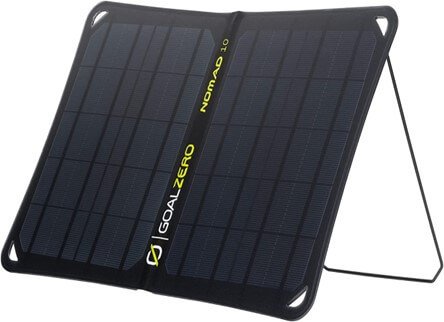
Features
- Rated capacity: 10 watts
- Weight: 1.12 lbs (approx.)
- Type: Monocrystalline
- Material: Plastic
Pros
- 10W, 6-7V Panel with USB port for small device charging
- Weighs just 1.12 lbs
- Fits almost anywhere because of its small form factor
- Can be hooked on backpack while hiking or propped up with 180° adjustable kickstand
- 1 year manufacturer warranty
Cons
- doesn’t charge at the rated 10W!
Conclusion
The Goal Zero Nomad 10 Portable Solar Panel is a great choice for outdoorsy folks who are looking to charge their phones, tablets, and other small devices on the go. This panel can be hooked on your backpack while hiking or propped up with its 180° adjustable kickstand.
Also, with its extremely small form factor and light-weight design, you can surely carry it around without much hassle!
2. BigBlue Portable Solar Panel Charger
The BigBlue Portable Solar Panel Charger is perfect for those who are always on the go. Whether you’re camping, hiking, or traveling, this charger will come in handy.
It features high-efficiency SunPower solar panels that can convert up to 24% of solar power into free energy. Not to mention, it has smart charge technology and is 100% safe! You can also charge multiple devices at once with this nifty little device. And if you have an emergency kit, this should definitely be a part of it!
Also, included with your purchase is the solar charger, a USB-A to USB-C Cable, a user manual, and a friendly customer service!
Features
- Rated capacity: 28 watts
- Weight: 1.57 lbs
- Maximum output: 5V/2.4A
- Operating temperatures: 14-158°F
Pros
- Can charge multiple devices at once
- Has smart charge technology and is 100% safe.
- Made with highly efficient SunPower solar panels that convert up to 24% of solar power into free energy
- Design is compact and lightweight
- Ideal for camping trips, hiking, backpacking, or traveling.
- Offers wide compatibility for charging your phone (Android and Apple)
Cons
- Does not come with a blocking diode on the outputs!
Conclusion
The BigBlue portable solar panel charger is a must-have in an emergency kit. It comes with smart charge technology, making it easy to charge multiple devices at once. The design is compact and lightweight, making it great for camping trips or travel.
Furthermore, this solar phone charger offers wide compatibility for charging your phone (Android and Apple) and small electronics with the sun’s help!
3. SunJack 25 Watt Foldable Solar Panel Charger
Introducing the SunJack 25 Watt Foldable Solar Panel Charger—your perfect solar-powered companion for all your off-grid adventures. These rugged and durable panels are weatherproof, thanks to their ETFE exterior layer, and fold down to the size of a tablet for easy portability.
Their integrated magnetic closure system keeps everything securely in place while on the go. Plus, their mesh pockets provide ample storage space for charging cables and other accessories. These are mono crystalline solar panels with ETFE construction which help provide maximum efficiency and UV ray permeability, while dual USB ports allow you to charge multiple devices at once.
Furthermore, these solar panels feature a built-in smart IC chip that intelligently identifies your device and provides the quickest yet safest charging speeds possible without overloading or overheating it in any way whatsoever. So, what are you waiting for? Get one of these and explore nature without limits!
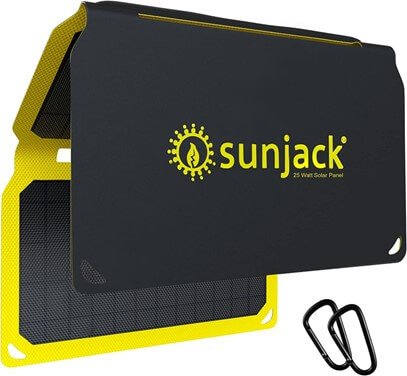
Features
- Rated capacity: 25 watts
- Type: Monocrystalline
- Weight: 1.9 lbs
- Warranty: 12 months
Pros
- Extremely rugged and durable
- Features a weatherproof ETFE exterior layer
- Compact panels fold down to the size of a table
- Integrated magnetic closure system
- Mesh pocket provides ample storage space
- Comes with Monocrystalline panels with ETFE construction which provides maximum efficiency and UV ray permeability
Cons
- It’s a bit heavy when compared to other similar products!
Conclusion
The SunJack 25 Watt Foldable Solar Panel Charger is a compact and rugged panel that’s perfect for camping, hiking, backpacking and any other outdoor activity. With its integrated magnetic closure system, you can be sure that your equipment is safe and sound wherever you go.
And with two USB ports and an integrated smart IC chip that intelligently identifies your device and provides the quickest, yet safest charging speed possible, you’ll never be without the power of the sun again!
4. BLAVOR Monocrystalline Foldable Solar Charger
Looking for a backpacking solar panel that’s easy to use and super-efficient? Well, look no more than the BLAVOR Monocrystalline Foldable Solar Charger! This unique charger is made with monocrystalline silicon solar cells and adopts multi-layered cell tech to convert sunlight into useable electricity.
With up to 26% high conversion efficiency, this charger is perfect for camping, hiking or any other outdoor trips. It also features QC3.0 24W and DC 18V1.6A Outputs, making it super easy to charge your devices on the go. Plus, the compact size and foldable design make it easy to carry with you wherever you go.
And for added durability, it features ETFE high transmittance film and 600D water-resistant fabrics – meaning this charger can withstand even the most rugged conditions!
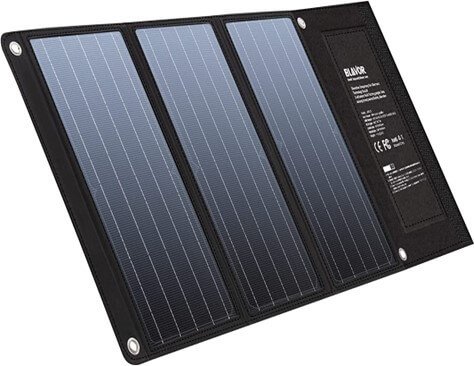
Features
- Rated capacity: 30 watts
- Type: Monocrystalline
- Weight: 2.40 lbs
- Waterproof certification: IP67
Pros
- Made with monocrystalline silicon solar cells
- Adopts multi-layered cell tech to convert sunlight to useable electricity
- Up to 26% high conversion efficiency
- QC3.0 24W and DC 18V1.6A Outputs
- Compact size and foldable design
Cons
- There are no such major cons worth mentioning!
Conclusion
Whether you’re camping, hiking, or just out and about, the BLAVOR Foldable Solar Charger is a great way to keep your devices charged up no matter where you are.
The charger is easy to hang on your backpack with its compact size and foldable design, and its high efficiency will help you carry less weight while maximizing the amount of sun power you can harness. If you need an extra boost of power outdoors, pick one up today!
5. MARBERO 30W Solar Panel Battery Charger
The MARBERO 30W solar panel comes with all the adapters you need to keep your DC devices full of juice without having to rely on a wall outlet. The10 included DC adapters are compatible with most solar generators/portable power stations on the market, making it easy to find one that fits your needs.
Additionally, the 18V output can also charge car refrigerators, air pumps, etc. With 3 USB output ports capable of charging smartphones and laptops at high speeds, this product is perfect for camping trips or any outdoor activities where conventional outlets may not be readily available.
Made from durable oxford cloth material that is IPX4 waterproof, dust resistant and even high temperature resistant, this charger is the perfect solution for anyone who needs an easy and efficient way to charge their devices while on the go!

Features
- Rated capacity: 30 watts
- Conversion rate: 24%
- Weight: 2.60 lbs
- Waterproof certification: IPX4
Pros
- Comes with 10 DC adapters
- Is compatible with most solar generators/portable power stations on the market
- 18V DC output can charge car refrigerator, air pump, etc.
- Features an IPX4 water and dust resistant rating
- Ideal for outdoor activities such as camping, hikes, picnics and even caravanning
Cons
- The instruction manual is quite useless (if you are trying to set up the device using it)!
Conclusion
The MARBERO 30W Solar Panel Battery Charger is a great addition to any outdoor activity. It comes with 10 DC adapters, so you can charge up your devices and other gadgets no matter where you are.
The 18V DC output can charge car refrigerator, air pump, etc. And finally, the IPX4 waterproof and dust resistant rating and high temperature resistant design makes it ideal for camping trips and even caravanning!
FAQs
1. What will a 200-watt solar panel run?
A 200-watt solar panel can provide enough power to run a small fridge, a coffee maker, a television, and other small appliances. It can also charge batteries or a solar generator for use in emergency situations!
2. Is 160W solar panel enough for camping?
With a 160W panel, you’ll be able to generate enough power for some basic lighting and charging small devices like phones or tablets.
If you’re planning on doing any cooking while camping, then you may want to invest in a higher wattage panel or even multiple panels so that you can run appliances like a portable stove or slow cooker.
However, if your main goal is simply staying charged up and keeping lights lit during an evening around the campfire, then 160 watts will suffice nicely!
3. Is a 12 or 24 volt solar system better?
A few factors influence the answer to this question. 12 volt solar systems are typically less expensive than 24 volt systems, but they may not be as efficient.
If you are looking for an affordable option, then a 12 volt system may be the best choice. However, if you want the most efficiency possible, then a 24 volt system is probably your best bet.
4. Are hiking solar panels worth it?
Yes, hiking solar panels are definitely worth it! They’re a great way to keep your devices charged while you’re on the go, and they’re relatively inexpensive.
Plus, they’re easy to set up and use. We would recommend them to anyone who enjoys spending a lot of time outdoors.
5. Is poly or mono solar better?
When it comes to solar panels, there are two main types: polycrystalline and monocrystalline. Both have their own unique benefits that make them better suited for different applications. Here’s a quick rundown of the pros and cons of each type to help you decide which is right for your needs.
Polycrystalline solar panels are made from multiple small crystals of silicon, while monocrystalline panels are made from a single large crystal. Polycrystal-based panels are less efficient than mono-based ones, but they’re also cheaper to manufacture. That makes them a good choice for large-scale commercial projects where cost is a major factor.
Mono solar cells tend to be more expensive than poly cells, but they’re also more efficient at converting sunlight into electricity. That makes them ideal for outdoor use like camping, backpacking, etc!
6. Which solar panel type is best?
There are a few different types of solar panels on the market, but which one is best? It really depends on your needs and what you’re looking for in a solar panel.
Monocrystalline solar panels are made from single silicon crystals, and they tend to be more efficient than other types of solar panels. They also have a longer lifespan, so if you’re looking for a long-term investment, monocrystalline might be the way to go!
7. Is active or passive solar better? (Home or Commercial)
There are a few key factors to consider when deciding if active or passive solar is the best option for you. Active solar systems require more initial investment but may provide greater long-term savings. Passive solar systems are typically less expensive up front but may not offer as much in terms of future energy savings.
Another consideration is how each type of system handles heat storage. Active solar systems use pumps and fans to circulate fluid or air through collectors and into your home, while passive solar relies on thermal mass (such as concrete) to store heat from the sun during the day so it can be released at night.
Finally, think about maintenance requirements when making your decision – active solar requires regular upkeep (including cleaning), while passive works best with minimal intervention.
8. How long do monocrystalline solar panels last?
Monocrystalline solar panels are built to last. They typically have a lifespan of 25-30 years with little to no performance degradation over time. In fact, most manufacturers offer warranties of 20-25 years for monocrystalline PV modules!
9. How do you attach solar panels to a backpack?
Solar panels can be attached to backpacks in a few different ways. The most common way is to use Velcro straps or similar fasteners to secure the panel to the backpack.
Some panels come with special attachment points that allow them to be clipped onto the backpack. Others may have loops or grommets that can be used to tie the panel onto the pack.
Whichever method you choose, make sure that the solar panel is securely attached so it doesn’t fall off while you’re hiking!
10. What are the best backpacking solar panels?
The best portable solar panels for backpacking are those that offer the most power in a lightweight and compact design.
- Goal Zero’s line of Nomad solar panels are some of the most popular on the market, and for good reason. They offer high-quality construction and powerful output in a package that is easy to transport.
- BigBlue Portable Solar Panel Charger is another great option, offering similar features.
- Finally, MARBERO makes an excellent choice for backpackers who need something even more compact and lightweight; their ultra slim solar panel weighs just over half a pound!
Additional Resources
If you are looking for more tutorials, walkthroughs and troubleshooting about camping and enjoying the outdoors, here are some additional posts to check out:
The Bottom Line
We hope you’ve found this guide to be helpful in your search for the best backpacking solar panels. We’ve done our best to highlight the features that matter most in a backpacking solar panel, and we’re sure that at least one of the products we’ve featured will be a great fit for you.
Whether you’re looking to charge your phone while hiking or keeping your electronics running on the trail, we think you’ll find at least one of these options to meets all of your needs.
If you have any questions or feedback about this article, or if you simply want to share a story or some advice, please feel free to leave us a comment below! Be safe and have fun.!

